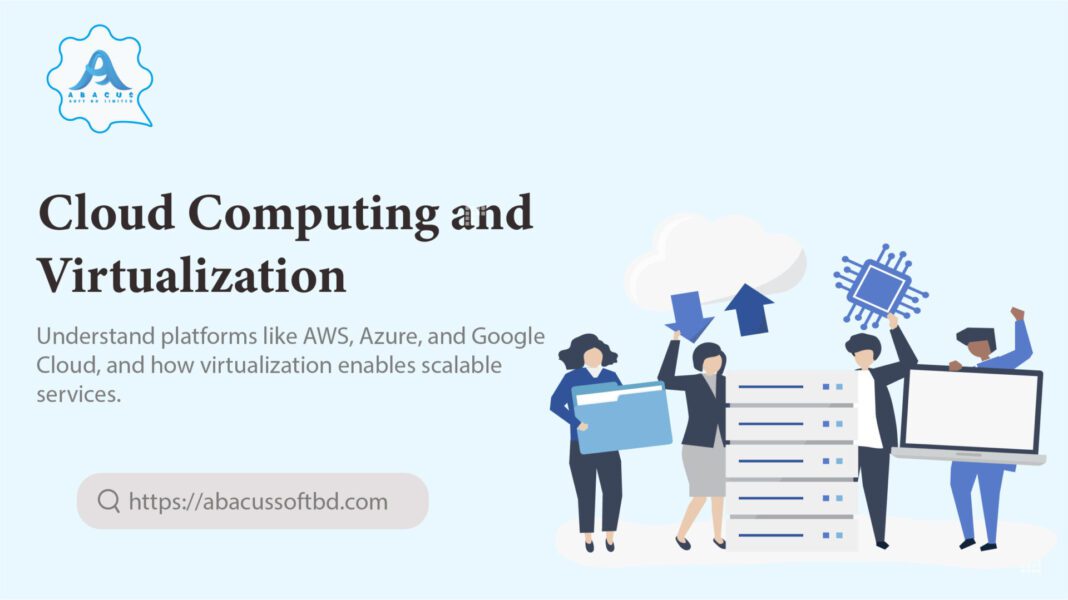Subtotal 0.00৳
Cloud Computing and Virtualization. In today’s world, technology is growing very fast. Two important parts of this growth are cloud computing and virtualization. These two terms may sound complex, but they are actually very useful and easy to understand.
In this blog, we will explain what they are, how they work, and why they matter.
What is Cloud Computing?
Cloud computing means storing. Opening data finishes the internet in its place of your computer’s hard drive. You don’t need to install software or buy expensive hardware. Instead, you can use services through the internet.
For example:
When you use Google Drive, Dropbox, or Microsoft OneDrive. You are using cloud computing. Your documents are not protected on your computer. They are saved in the cloud.
Main Benefits of Cloud Computing
- Easy Access – You can access your data from anywhere.
- Cost Saving – No need to buy physical servers.
- Flexibility – Use more or fewer resources based on your needs.
- Security – Cloud providers offer strong security features.
- Backup and Recovery – Your data stays safe even if your device is lost.
What is Virtualization?
Virtualization is a skill that makes computer-generated forms of mental policies. This includes virtual machines, storage, and networks. It helps one physical machine do the work of many.
For instance:
You can run Windows and Linux on the same computer at the same time. This is possible because of virtualization.
Types of Virtualization
- Server Virtualization – One server works as many virtual servers.
- Storage Virtualization – Combines many storage devices into one.
- Network Virtualization – Makes one network work as many virtual networks.
- Desktop Virtualization – Access your desktop from anywhere.
How Cloud Computing and Virtualization Work Together
Cloud computing and virtualization are closely related. In fact, virtualization is the basis of cloud computing. It allows cloud providers to offer many services on the same hardware.
For example:
Amazon Web Services (AWS) uses virtualization. To run many customer applications on one server.
Similarly, Google Cloud and Microsoft Azure use this method too.
Benefits of Using Both Together
- Better Resource: Using virtualization lets cloud providers use their servers more efficiently.
- Quick Deployment: New applications can be launched fast using cloud services.
- High-performance: Applications run smoothly because of powerful virtual machines.
- Disaster Recovery: In case of a system failure, data can be restored quickly.
- Lower Costs: You only pay for what you use.
Real-Life Use Cases
For Businesses:
Various companies use custom cloud computing to standardize customer data, run software. And manage operations. Not only that, but virtualization helps them save money by using fewer physical servers.
For Developers:
Developers can test software on different platforms using virtual machines. Without buying extra devices.
For Education:
Schools and colleges use cloud platforms for online classes and data storage.
Popular Cloud Service Models
1.IaaS: offers computer-generated machines, storage, and networks.
For example: Google Compute Engine.
- PaaS: proposals geared for creators to build apps.
For instance: Google App Engine.
Cloud Deployment Models
- Public Cloud – Services shared with many users.
- Private Cloud – Services used by only one company.
To illustrate:
A company may store public data in a public cloud but keep sensitive data in a private cloud.
Security in Cloud and Virtual Environments
Security is very important. Cloud providers take strong steps to protect user data.
Some key features include:
- Encryption of data
- Multi-factor authentication
- Regular updates and patches
- Backups and recovery tools
But users must also follow best practices. Like consuming tough passwords and apprising software.
Challenges and Solutions
Although cloud computing and virtualization offer many benefits, they also face some challenges.
Common Challenges:
- Downtime – Servers may go down sometimes.
- Security Risks – Data can be hacked if not protected well.
- Compatibility Issues – Some apps may not work in a virtual setup.
Solutions:
- Choose trusted cloud providers.
- Use proper security settings.
- Keep systems updated.
- Train employees about cloud safety.
Why It Matters for Bangladesh
Bangladesh is growing fast in the tech field. Cloud computing and virtualization can help businesses, schools. And government services become more digital.
For example:
- Local startups can use cloud services to build and grow apps.
- Educational organizations can track computer-generated labs and online classes.
- Government offices can go paperless and work faster.
In fact, many companies in Bangladesh have already moved to the cloud. At Abacus Soft BD Limited. We support businesses in their digital journey with modern IT solutions.
Future of Cloud and Virtualization
The future is bright. Artificial Intelligence (AI), Big Data. And the Internet of Things (IoT) is becoming part of cloud computing. Virtualization will continue to make systems faster and cheaper.
Undoubtedly, more companies will adopt these technologies in the coming years.
In Conclusion
Cloud computing and virtualization are changing the way we use technology. They offer flexibility, save money, and help us work smarter.
To sum up:
- Virtualization means generating computer-generated forms of organizations.
- Together, they provide powerful and cost-effective solutions.
- Bangladesh is ready to enjoy these technologies.
If you want to learn more or need IT solutions for your business, feel free to contact us at

